MeLE has released a new and updated version of the Quieter mini PC called the Quieter3Q. Like before, it is a passive mini PC but now features the latest low-powered Intel Celeron Jasper Lake CPU and an upgraded PCIe 3.0 x2 M.2 2280 NVMe SSD slot. MeLE has kindly sent one for review and I’ve looked at performance running both Windows and Ubuntu and connecting an eGPU.
MeLE Quieter3Q Hardware Overview
The MeLE Quieter3Q is physically the same as before consisting of a 131 x 81 x 18.3mm (5.16 x 3.19 x 0.72 inches) rectangular plastic case with a metal base plate. The top half of the case is finely grooved to mimic the fins of a heat spreader but is made of plastic rather than metal to allow reception to the WiFi antennas as one is directly connected to it. As a passively cooled mini PC, it uses Intel’s 10 nm Jasper Lake N5105 processor which is a quad-core 4-thread 2.00 GHz Celeron processor boosting to 2.90 GHz with Intel’s UHD Graphics.
The front panel just has an illuminated power button whilst the rear panel includes a USB 3.0 port, a headphone jack, a micro-SD card slot, two HDMI ports, a Type-C USB port for power only, and a gigabit Ethernet port. The left panel has a Kensington security slot and the right panel has three more USB 3.0 ports.
The review model included a soldered-on 128GB eMMC drive and soldered-on 8GB LPDDR4 3200 MHz single-channel memory that was configured to run at 2933 MHz:
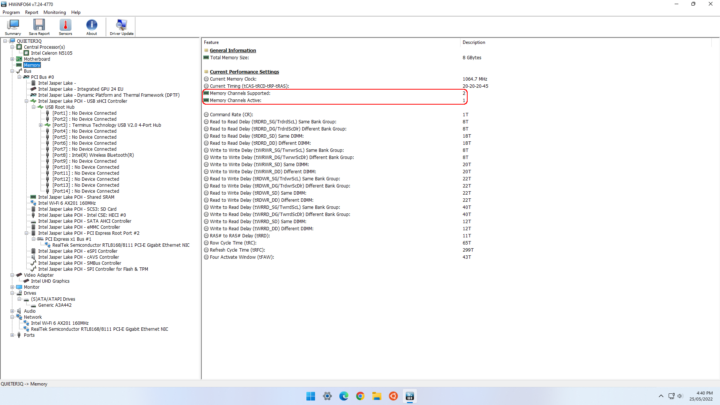
Additionally, there is soldered-on WiFi 6 (or 802.11ax) as well as the ability to add an M.2 2280 NVMe SSD drive:
The specifications state:
and list the USB ports as ‘USB 3.0 (Gen 1)’ so I tested them together using a Samsung 980 PRO PCle 4.0 NVMe M.2 SSD housed in a ‘USB to M.2 NVMe adapter’ (ORICO M2PAC3-G20 M.2 NVMe SSD Enclosure) which showed that the first two ports on the right side were actually ‘USB 3.1’ (USB 3.2 Gen 2×1 i.e. 10 Gbit/s):
and that only the third port together with the rear port was ‘USB 3.0’ (USB 3.2 Gen 1×1 i.e. 5 Gbit/s):
Box contents
In the box, you get a power adapter and cord together with a plug adapter appropriate for your country, a quick start guide and a thermal pad for applying to an M.2 drive. Also included was the optionally available VESA mounting bracket together with a small packet of miscellaneous screws:
Review Methodology
When reviewing mini PCs, I typically look at their performance under both Windows and Linux (Ubuntu) and compare them against some of the more recently released mini PCs. I now review using Windows 11 version 21H2 and Ubuntu 22.04 LTS. I test with a selection of commonly used Windows benchmarks and/or equivalents for Linux together with Thomas Kaiser’s ‘sbc-bench’ which is a small set of different CPU performance tests focusing on server performance when run on Ubuntu. I also use ‘Phoronix Test Suite’ version 10.8.3 and benchmark with the same set of tests on both Windows and Ubuntu for comparison purposes. On Ubuntu, I also compile the v5.15 Linux kernel using the default config as a test of performance using a real-world scenario.
Prior to benchmarking, I perform all necessary installations and updates to run the latest version of the OS. I also capture some basic details of the device for each OS.
MeLE Quieter3Q Windows Performance
Initially, the MeLE Quieter3Q came installed with a licensed copy of Windows 11 Pro version 21H2 which after applying updates was build 22000.708. A quick look at the hardware information shows each is aligned to the specifications:
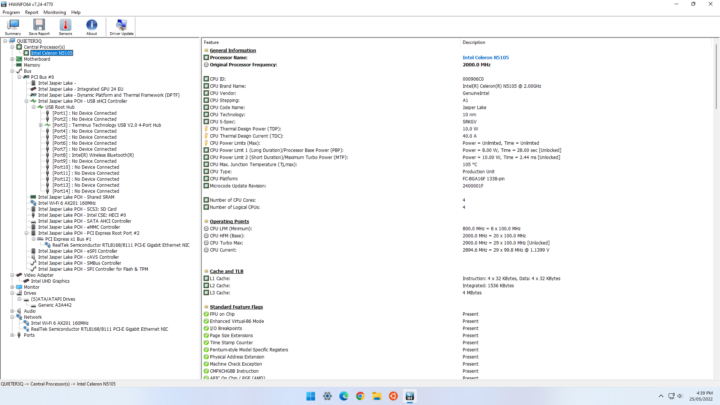
Similar to when I reviewed another mini PC with Intel’s Jasper Lake N5105 processor, the iGPU showed limited details in HWiNFO and was unknown to GPU-Z:
A brief check showed working audio, Wi-Fi, Bluetooth, Ethernet, HDMI, and microSD card:
I then set the power mode to ‘High performance’ and ran my standard set of benchmarking tools to look at performance under Windows:
I also tested Cinebench R23:
For my specific set of Phoronix Test Suite tests the results were:
All these results can then be compared with other recent mini PCs:
The results show the slight impact caused by the slower eMMC storage and thermal throttling which is covered further in the ‘thermals’ section below.
Ubuntu 22.04 Performance
After shrinking the Windows partition and creating a new 50GB partition I installed Ubuntu using an Ubuntu 22.04 ISO as dual boot. After installation and updates a brief check showed working audio, Wi-Fi, Bluetooth, Ethernet, HDMI, and micro-SD card:
The key hardware information under Ubuntu 22.04 is as follows:
|
1 2 3 4 5 6 7 8 9 10 11 12 13 14 15 16 17 18 19 20 21 22 23 24 25 26 27 28 29 30 31 32 33 34 35 36 37 38 39 40 41 42 43 44 45 46 47 48 49 50 51 52 53 54 55 56 57 58 59 60 61 62 63 64 65 66 67 68 69 70 71 72 73 74 75 76 77 78 79 80 81 82 83 84 85 86 87 88 89 90 91 92 93 94 95 96 97 98 99 100 101 102 103 104 105 106 107 108 109 110 111 112 113 114 115 116 117 118 119 120 121 122 123 124 125 126 127 128 129 130 131 132 133 134 135 136 137 138 139 140 141 142 143 144 145 146 147 148 149 150 151 152 153 154 155 156 157 158 159 160 161 162 163 164 165 166 167 168 169 170 171 172 173 174 175 176 177 178 179 180 181 182 183 184 185 186 187 188 189 190 191 192 193 194 195 196 197 198 199 200 201 202 203 204 205 206 207 208 209 210 211 212 213 214 215 216 217 218 219 220 221 222 223 224 225 226 227 228 229 230 231 232 233 234 235 236 237 238 239 240 241 242 243 244 245 246 247 248 249 250 251 252 253 254 255 256 257 258 259 260 261 262 263 |
linuxium@Quieter-3:~$ lsb_release -a Distributor ID: Ubuntu Description: Ubuntu 22.04 LTS Release: 22.04 Codename: jammy linuxium@Quieter-3:~$ linuxium@Quieter-3:~$ uname -a Linux Quieter-3 5.15.0-33-generic #34-Ubuntu SMP Wed May 18 13:34:26 UTC 2022 x86_64 x86_64 x86_64 GNU/Linux linuxium@Quieter-3:~$ linuxium@Quieter-3:~$ inxi -Fzc0y-1 System: Kernel: 5.15.0-33-generic x86_64 bits: 64 Console: pty pts/1 Distro: Ubuntu 22.04 LTS (Jammy Jellyfish) Machine: Type: Mini-pc System: Fanless Mini PC product: Quieter 3 v: N/A serial: <filter> Mobo: Fanless Mini PC model: Rev JSL1 1.10 serial: <filter> UEFI: American Megatrends LLC. v: ML_JPL1V1.0 date: 03/15/2022 CPU: Info: quad core model: Intel Celeron N5105 bits: 64 type: MCP cache: L2: 1.5 MiB Speed (MHz): avg: 2213 min/max: 800/2900 cores: 1: 1736 2: 2160 3: 2062 4: 2897 Graphics: Device-1: Intel JasperLake [UHD Graphics] driver: i915 v: kernel Display: server: X.Org v: 1.22.1.1 driver: gpu: i915 note: X driver n/a resolution: 1920x1080~60Hz OpenGL: renderer: Mesa Intel UHD Graphics (JSL) v: 4.6 Mesa 22.0.1 Audio: Device-1: Intel driver: snd_hda_intel Sound Server-1: ALSA v: k5.15.0-33-generic running: yes Sound Server-2: PulseAudio v: 15.99.1 running: yes Sound Server-3: PipeWire v: 0.3.48 running: yes Network: Device-1: Intel Wi-Fi 6 AX201 160MHz driver: iwlwifi IF: wlp0s20f3 state: down mac: <filter> Device-2: Realtek RTL8111/8168/8411 PCI Express Gigabit Ethernet driver: r8169 IF: enp1s0 state: up speed: 1000 Mbps duplex: full mac: <filter> Bluetooth: Device-1: Intel AX201 Bluetooth type: USB driver: btusb Report: hciconfig ID: hci0 state: up address: <filter> bt-v: 3.0 Drives: Local Storage: total: 144.96 GiB used: 23.61 GiB (16.3%) ID-1: /dev/mmcblk0 vendor: Samsung model: SP32G size: 29.72 GiB ID-2: /dev/mmcblk1 model: A3A442 size: 115.23 GiB Partition: ID-1: / size: 48.91 GiB used: 22.29 GiB (45.6%) fs: ext4 dev: /dev/mmcblk1p5 ID-2: /boot/efi size: 96 MiB used: 59.3 MiB (61.8%) fs: vfat dev: /dev/mmcblk1p1 Swap: ID-1: swap-1 type: file size: 2 GiB used: 0 KiB (0.0%) file: /swapfile Sensors: System Temperatures: cpu: 27.8 C mobo: N/A Fan Speeds (RPM): N/A Info: Processes: 223 Uptime: 1h 12m Memory: 7.52 GiB used: 1.26 GiB (16.8%) Shell: new-review-test inxi: 3.3.13 linuxium@Quieter-3:~$ linuxium@Quieter-3:~$ df -h Filesystem Size Used Avail Use% Mounted on tmpfs 770M 1.9M 769M 1% /run /dev/mmcblk1p5 49G 23G 25G 49% / tmpfs 3.8G 0 3.8G 0% /dev/shm tmpfs 5.0M 4.0K 5.0M 1% /run/lock /dev/mmcblk1p1 96M 60M 37M 62% /boot/efi tmpfs 770M 2.4M 768M 1% /run/user/1000 /dev/mmcblk0p1 30G 1.3G 27G 5% /media/linuxium/547c64cb-9a92-41f7-a6b1-59c033ddad98 linuxium@Quieter-3:~$ linuxium@Quieter-3:~$ lsblk -a NAME MAJ:MIN RM SIZE RO TYPE MOUNTPOINTS loop0 7:0 0 4K 1 loop /snap/bare/5 loop1 7:1 0 61.9M 1 loop /snap/core20/1405 loop2 7:2 0 160.5M 1 loop /snap/firefox/1377 loop3 7:3 0 61.9M 1 loop /snap/core20/1494 loop4 7:4 0 162.2M 1 loop /snap/firefox/1406 loop5 7:5 0 248.8M 1 loop /snap/gnome-3-38-2004/99 loop6 7:6 0 81.3M 1 loop /snap/gtk-common-themes/1534 loop7 7:7 0 45.9M 1 loop /snap/snap-store/575 loop8 7:8 0 45.9M 1 loop /snap/snap-store/582 loop9 7:9 0 43.6M 1 loop /snap/snapd/15177 loop10 7:10 0 284K 1 loop /snap/snapd-desktop-integration/10 loop11 7:11 0 44.7M 1 loop /snap/snapd/15904 loop12 7:12 0 0B 0 loop mmcblk1 179:0 0 115.2G 0 disk ├─mmcblk1p1 179:1 0 100M 0 part /boot/efi ├─mmcblk1p2 179:2 0 16M 0 part ├─mmcblk1p3 179:3 0 64.2G 0 part ├─mmcblk1p4 179:4 0 900M 0 part └─mmcblk1p5 179:5 0 50G 0 part / mmcblk1boot0 179:8 0 4M 1 disk mmcblk1boot1 179:16 0 4M 1 disk mmcblk0 179:24 0 29.7G 0 disk └─mmcblk0p1 179:25 0 29.7G 0 part /media/linuxium/547c64cb-9a92-41f7-a6b1-59c033ddad98 linuxium@Quieter-3:~$ linuxium@Quieter-3:~$ sudo lshw -C cpu *-cpu description: CPU product: Intel(R) Celeron(R) N5105 @ 2.00GHz vendor: Intel Corp. physical id: b bus info: cpu@0 version: 6.156.0 serial: <filter> slot: U3E1 size: 2899MHz capacity: 2900MHz width: 64 bits clock: 100MHz capabilities: lm fpu fpu_exception wp vme de pse tsc msr pae mce cx8 apic sep mtrr pge mca cmov pat pse36 clflush dts acpi mmx fxsr sse sse2 ss ht tm pbe syscall nx rdtscp x86-64 constant_tsc art arch_perfmon pebs bts rep_good nopl xtopology nonstop_tsc cpuid aperfmperf tsc_known_freq pni pclmulqdq dtes64 monitor ds_cpl vmx est tm2 ssse3 sdbg cx16 xtpr pdcm sse4_1 sse4_2 x2apic movbe popcnt tsc_deadline_timer aes xsave rdrand lahf_lm 3dnowprefetch cpuid_fault epb cat_l2 cdp_l2 ssbd ibrs ibpb stibp ibrs_enhanced tpr_shadow vnmi flexpriority ept vpid ept_ad fsgsbase tsc_adjust smep erms rdt_a rdseed smap clflushopt clwb intel_pt sha_ni xsaveopt xsavec xgetbv1 xsaves split_lock_detect dtherm ida arat pln pts hwp hwp_notify hwp_act_window hwp_epp hwp_pkg_req umip waitpkg gfni rdpid movdiri movdir64b md_clear flush_l1d arch_capabilities cpufreq configuration: cores=4 enabledcores=4 microcode=603979807 threads=4 linuxium@Quieter-3:~$ linuxium@Quieter-3:~$ sudo lshw -C memory *-firmware description: BIOS vendor: American Megatrends International, LLC. physical id: 0 version: ML_JPL1V1.0 date: 03/15/2022 size: 64KiB capacity: 8MiB capabilities: pci upgrade shadowing cdboot bootselect socketedrom edd int13floppy1200 int13floppy720 int13floppy2880 int5printscreen int14serial int17printer acpi usb biosbootspecification uefi *-memory description: System Memory physical id: 4 slot: System board or motherboard size: 8GiB *-bank:0 description: Row of chips LPDDR4 Synchronous 3200 MHz (0.3 ns) vendor: SK Hynix physical id: 0 serial: <filter> slot: Controller0-ChannelA size: 8GiB width: 32 bits clock: 3200MHz (0.3ns) *-bank:1 description: Project-Id-Version: lshwReport-Msgid-Bugs-To: FULL NAME <EMAIL@ADDRESS>PO-Revision-Date: 2012-02-02 13:04+0000Last-Translator: Joel Addison <jaddi27@gmail.com>Language-Team: English (Australia) <en_AU@li.org>MIME-Version: 1.0Content-Type: text/plain; charset=UTF-8Content-Transfer-Encoding: 8bitX-Launchpad-Export-Date: 2022-04-15 01:03+0000X-Generator: Launchpad (build 5cc3bd61c85a328825183f316ddd801c0f7d7ef2)Project-Id-Version: lshwReport-Msgid-Bugs-To: FULL NAME <EMAIL@ADDRESS>PO-Revision-Date: 2012-02-02 13:04+0000Last-Translator: Joel Addison <jaddi27@gmail.com>Language-Team: English (Australia) <en_AU@li.org>MIME-Version: 1.0Content-Type: text/plain; charset=UTF-8Content-Transfer-Encoding: 8bitX-Launchpad-Export-Date: 2022-04-15 01:03+0000X-Generator: Launchpad (build 5cc3bd61c85a328825183f316ddd801c0f7d7ef2) [empty] physical id: 1 slot: Controller0-ChannelB-DIMM0 *-cache:0 description: L1 cache physical id: 8 slot: L1 Cache size: 256KiB capacity: 256KiB capabilities: synchronous internal write-back configuration: level=1 *-cache:1 description: L2 cache physical id: 9 slot: L2 Cache size: 1536KiB capacity: 1536KiB capabilities: synchronous internal write-back unified configuration: level=2 *-cache:2 description: L3 cache physical id: a slot: L3 Cache size: 4MiB capacity: 4MiB capabilities: synchronous internal write-back unified configuration: level=3 *-memory UNCLAIMED description: RAM memory product: Intel Corporation vendor: Intel Corporation physical id: 14.2 bus info: pci@0000:00:14.2 version: 01 width: 64 bits clock: 33MHz (30.3ns) capabilities: pm cap_list configuration: latency=0 resources: iomemory:600-5ff iomemory:600-5ff memory:6001128000-6001129fff memory:600112e000-600112efff linuxium@Quieter-3:~$ linuxium@Quieter-3:~$ free -mh total used free shared buff/cache available Mem: 7.5Gi 768Mi 5.7Gi 263Mi 1.1Gi 6.3Gi Swap: 2.0Gi 0B 2.0Gi linuxium@Quieter-3:~$ linuxium@Quieter-3:~$ sudo lshw -C network *-network description: Wireless interface product: Wi-Fi 6 AX201 160MHz vendor: Intel Corporation physical id: 14.3 bus info: pci@0000:00:14.3 logical name: wlp0s20f3 version: 01 serial: <filter> width: 64 bits clock: 33MHz capabilities: pm msi pciexpress msix bus_master cap_list ethernet physical wireless configuration: broadcast=yes driver=iwlwifi driverversion=5.15.0-33-generic firmware=66.f1c864e0.0 QuZ-a0-hr-b0-66.u latency=0 link=no multicast=yes wireless=IEEE 802.11 resources: iomemory:600-5ff irq:16 memory:6001124000-6001127fff *-network description: Ethernet interface product: RTL8111/8168/8411 PCI Express Gigabit Ethernet Controller vendor: Realtek Semiconductor Co., Ltd. physical id: 0 bus info: pci@0000:01:00.0 logical name: enp1s0 version: 15 serial: <filter> size: 1Gbit/s capacity: 1Gbit/s width: 64 bits clock: 33MHz capabilities: pm msi pciexpress msix bus_master cap_list ethernet physical tp mii 10bt 10bt-fd 100bt 100bt-fd 1000bt-fd autonegotiation configuration: autonegotiation=on broadcast=yes driver=r8169 driverversion=5.15.0-33-generic duplex=full firmware=rtl8168h-2_0.0.2 02/26/15 ip=<filter> latency=0 link=yes multicast=yes port=twisted pair speed=1Gbit/s resources: irq:17 ioport:3000(size=256) memory:7fc04000-7fc04fff memory:7fc00000-7fc03fff linuxium@Quieter-3:~$ linuxium@Quieter-3:~$ sudo lshw -C display *-display description: VGA compatible controller product: JasperLake [UHD Graphics] vendor: Intel Corporation physical id: 2 bus info: pci@0000:00:02.0 logical name: /dev/fb0 version: 01 width: 64 bits clock: 33MHz capabilities: pciexpress msi pm vga_controller bus_master cap_list rom fb configuration: depth=32 driver=i915 latency=0 mode=2560x1080 resolution=2560,1080 visual=truecolor xres=2560 yres=1080 resources: iomemory:600-5ff iomemory:400-3ff irq:135 memory:6000000000-6000ffffff memory:4000000000-400fffffff ioport:4000(size=64) memory:c0000-dffff linuxium@Quieter-3:~$ linuxium@Quieter-3:~$ dmesg | grep "MMC card" [ 1.153793] mmc1: new HS400 Enhanced strobe MMC card at address 0001 linuxium@Quieter-3:~$ linuxium@Quieter-3:~$ dmesg | egrep -i sdhci\|mmc [ 0.153769] PCI: MMCONFIG for domain 0000 [bus 00-ff] at [mem 0xc0000000-0xcfffffff] (base 0xc0000000) [ 0.153769] PCI: MMCONFIG at [mem 0xc0000000-0xcfffffff] reserved in E820 [ 0.999256] sdhci: Secure Digital Host Controller Interface driver [ 0.999258] sdhci: Copyright(c) Pierre Ossman [ 1.005804] sdhci-pci 0000:00:14.5: SDHCI controller found [8086:4df8] (rev 1) [ 1.005820] sdhci-pci 0000:00:14.5: enabling device (0000 -> 0002) [ 1.016304] mmc0: SDHCI controller on PCI [0000:00:14.5] using ADMA 64-bit [ 1.016399] sdhci-pci 0000:00:1a.0: SDHCI controller found [8086:4dc4] (rev 1) [ 1.017298] mmc1: CQHCI version 5.10 [ 1.017528] mmc1: SDHCI controller on PCI [0000:00:1a.0] using ADMA 64-bit [ 1.153773] mmc1: Command Queue Engine enabled [ 1.153793] mmc1: new HS400 Enhanced strobe MMC card at address 0001 [ 1.178769] mmcblk1: mmc1:0001 A3A442 115 GiB [ 1.182078] mmcblk1: p1 p2 p3 p4 p5 [ 1.182479] mmcblk1boot0: mmc1:0001 A3A442 4.00 MiB [ 1.182799] mmcblk1boot1: mmc1:0001 A3A442 4.00 MiB [ 1.183130] mmcblk1rpmb: mmc1:0001 A3A442 16.0 MiB, chardev (239:0) [ 1.575385] EXT4-fs (mmcblk1p5): mounted filesystem with ordered data mode. Opts: (null). Quota mode: none. [ 2.089021] EXT4-fs (mmcblk1p5): re-mounted. Opts: errors=remount-ro. Quota mode: none. [ 3442.197773] mmc0: new ultra high speed SDR104 SDHC card at address aaaa [ 3442.198597] mmcblk0: mmc0:aaaa SP32G 29.7 GiB [ 3442.208961] mmcblk0: p1 [ 3442.381015] EXT4-fs (mmcblk0p1): mounted filesystem with ordered data mode. Opts: errors=remount-ro. Quota mode: none. linuxium@Quieter-3:~$ linuxium@Quieter-3:~$ lsusb Bus 002 Device 001: ID 1d6b:0003 Linux Foundation 3.0 root hub Bus 001 Device 003: ID 8087:0026 Intel Corp. AX201 Bluetooth Bus 001 Device 006: ID 093a:2510 Pixart Imaging, Inc. Optical Mouse Bus 001 Device 005: ID 10d5:55a4 Uni Class Technology Co., Ltd 4 Port KVMSwicther Bus 001 Device 004: ID 046d:c31c Logitech, Inc. Keyboard K120 Bus 001 Device 002: ID 1a40:0101 Terminus Technology Inc. Hub Bus 001 Device 001: ID 1d6b:0002 Linux Foundation 2.0 root hub linuxium@Quieter-3:~$ linuxium@Quieter-3:~$ lspci -nn 00:00.0 Host bridge [0600]: Intel Corporation Device [8086:4e24] 00:02.0 VGA compatible controller [0300]: Intel Corporation JasperLake [UHD Graphics] [8086:4e61] (rev 01) 00:04.0 Signal processing controller [1180]: Intel Corporation Dynamic Tuning service [8086:4e03] 00:14.0 USB controller [0c03]: Intel Corporation Device [8086:4ded] (rev 01) 00:14.2 RAM memory [0500]: Intel Corporation Device [8086:4def] (rev 01) 00:14.3 Network controller [0280]: Intel Corporation Wi-Fi 6 AX201 160MHz [8086:4df0] (rev 01) 00:14.5 SD Host controller [0805]: Intel Corporation Device [8086:4df8] (rev 01) 00:16.0 Communication controller [0780]: Intel Corporation Management Engine Interface [8086:4de0] (rev 01) 00:17.0 SATA controller [0106]: Intel Corporation Device [8086:4dd3] (rev 01) 00:1a.0 SD Host controller [0805]: Intel Corporation Device [8086:4dc4] (rev 01) 00:1c.0 PCI bridge [0604]: Intel Corporation Device [8086:4db9] (rev 01) 00:1f.0 ISA bridge [0601]: Intel Corporation Device [8086:4d87] (rev 01) 00:1f.3 Audio device [0403]: Intel Corporation Device [8086:4dc8] (rev 01) 00:1f.4 SMBus [0c05]: Intel Corporation JaserLake SMBus [8086:4da3] (rev 01) 00:1f.5 Serial bus controller [0c80]: Intel Corporation JaserLake SPI (flash) Controller [8086:4da4] (rev 01) 01:00.0 Ethernet controller [0200]: Realtek Semiconductor Co., Ltd. RTL8111/8168/8411 PCI Express Gigabit Ethernet Controller [10ec:8168] (rev 15) linuxium@Quieter-3:~$ |
I then set the CPU Scaling Governor to ‘performance’ and ran my Linux benchmarks for which the majority of the results are text-based but the graphical ones included:
and the latter can be directly compared to when run in Windows using the OpenGL render:
I also ran PassMark PerformanceTest Linux:
which can be directly compared to the results from when it was run on Windows:
For the same set of Phoronix Test Suite tests the results were:
The complete results together with a comparison against other recent mini PCs are:
Video playback in browsers & Kodi
For real-world testing, I played some videos in Edge and Chrome on Windows and in Firefox and Chrome on Ubuntu. On Edge the initial codec for a video is ‘av01’ however as it then typically struggles to play the video it switches to ‘vp09’ whereas Chrome always used ‘vp09’:
I also played variously encoded videos in Kodi all of which played up to 8K @ 30 FPS without issue and used hardware for decoding:
However whilst hardware decoding was used when trying to play 8K @ 60 FPS videos it resulted in frame skipping and juddery playback:
NVMe Performance
As mentioned in the introduction, the MeLE Quieter3Q also supports an M.2 2280 NVMe SSD drive so I decided to test it using a Samsung 980 PRO PCle 4.0 NVMe M.2 SSD which connects as expected via PCIe 3.0 x2 with a link speed of 8.0 GT/s:
and the performance obtained was also as expected given this lane limitation:
MeLE Quieter3Q with eGPU
It is also possible to use the M.2 2280 NVMe SSD slot to connect an eGPU. To test I used a GT 1030 installed in ADT-Link’s R43SF ‘M.2 NVMe to PCI-Express x16 Extension Cable’ powered by an SFX power supply:
After installing an Nvidia driver the eGPU shows up as connected via ‘PCI Express x2 Gen3’:
and similarly in GPU-Z:
Running CUDA-Z gave an indication of the performance to expect:
I then ran a few graphical-orientated benchmarks including:
to demonstrate the potential improvement possible when using an eGPU. It should be noted however that whilst adding an eGPU is possible, the limitations of the low-powered CPU will have an impact on overall performance once a more powerful GPU is used.
Thermals
Running a stress test on Ubuntu saw the CPU temperature rise quickly to 60°C and then drop to 52°C before slowly climbing to a peak temperature of 73°C with a maximum average temperature of 69.5°C:
If the CPU frequency is monitored during the stress test it can be seen that the initial temperature peak is caused by the CPU running at an average of 2734 MHz for the ‘PL1’ duration after which it thermal throttles and drops to an average frequency of 2427 MHz to prevent overheating:
During the stress test, the maximum temperature I recorded on the top of the device was around 55.6°C at an ambient room temperature of 14.1°C with the device not being too hot to touch.
Networking (Ethernet and WiFi)
Initially, network connectivity throughput was measured on Ubuntu using ‘iperf’ however the results were unexpected with unusually low 5.0 GHz download speeds and slower than expected Ethernet upload speeds. As a result, I reran the tests using ‘iperf3’ and then repeated the tests on Windows. I performed each test three times however on Ubuntu the Ethernet runs had noticeable variations as did the 5.0 GHz download runs so these tests were performed five times with the highest and lowest values being discarded and then all results were averaged::
As can be seen the network performance on Windows is more aligned to expectations than on Ubuntu and it is not currently determined whether this is a result of the distro release used or the driver versions used by this distro.
MeLE Quieter3Q Power Consumption
Power consumption was measured as follows:
- Initially plugged in – 1.2 Watts
- Powered off (shutdown) – 0.4 Watts (Windows) and 0.0 Watts (Ubuntu)
- BIOS – 8.6 Watts
- GRUB boot menu – 8.3 Watts
- Idle – 4.0 Watts (Windows) and 2.4 Watts (Ubuntu)
- CPU stressed – 12.0 Watts (Windows ‘cinebench’) and 10.9 Watts (Ubuntu ‘stress’)
- Video playback – 8.2 Watts (Windows Edge 4K30fps) and 12.1 Watts (Ubuntu Chrome 4K30fps)
BIOS
Powering up the mini PC and hitting the F7 key results in a boot menu that includes access to the BIOS which is unrestricted.
Final Observations
The Quieter3Q offers a notable improvement over its predecessor. Whilst the physical appearance and external port configuration are similar, both the CPU and iGPU are more powerful and the M.2 NVMe slot is now PCIe Gen 3 rather than Gen 2 resulting in a doubling of bandwidth which is significant when you only get two lanes.
| Highlights | Limitations |
|---|---|
| Internal PCIe 3.0 x2 M.2 NVMe slot | Slow eMMC internal storage |
| Passively cooled | Single-channel memory |
| MicroSD card | Unusual network performance on Ubuntu |
I’d like to thank MeLE for providing the Quieter3Q for review. It retails through MeLE on Amazon for around $259 for the current 8GB/128GB configuration.

Ian is interested in mini PCs and helps with reviews of mini PCs running Windows, Ubuntu and other Linux operating systems. You can follow him on Facebook or Twitter.
Support CNX Software! Donate via cryptocurrencies, become a Patron on Patreon, or purchase goods on Amazon or Aliexpress


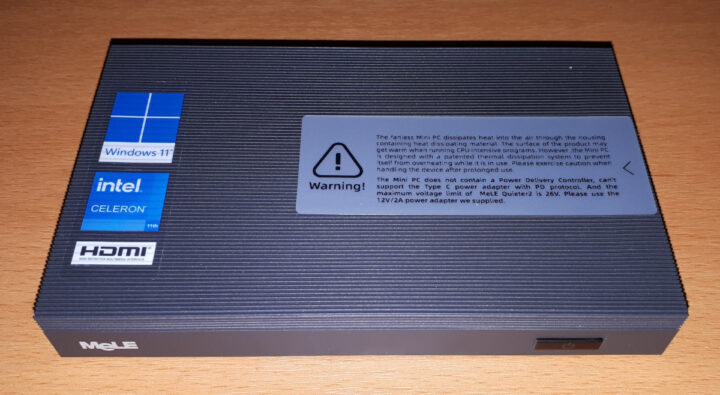
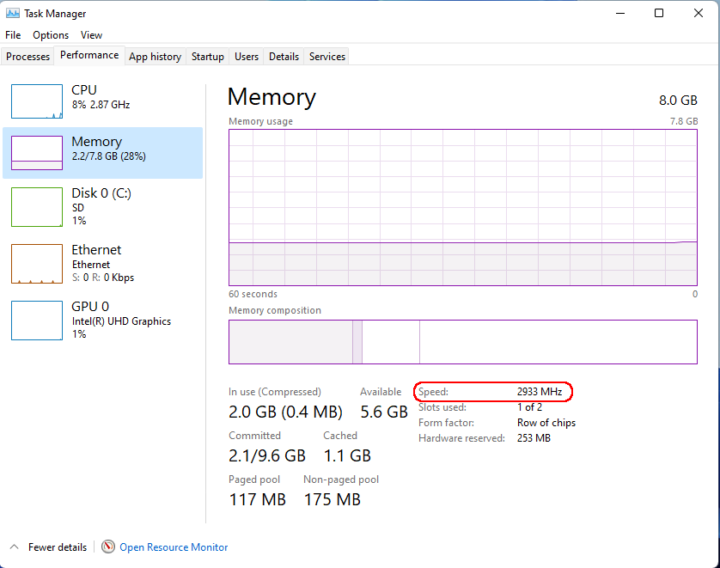
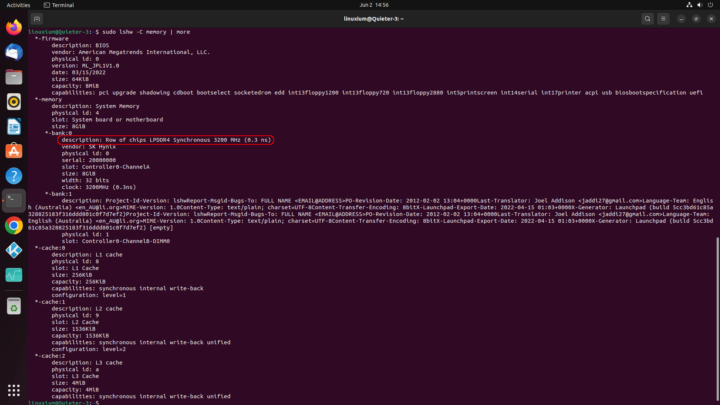
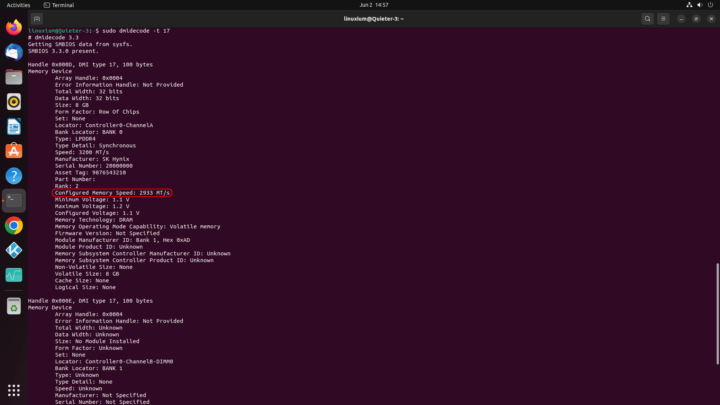
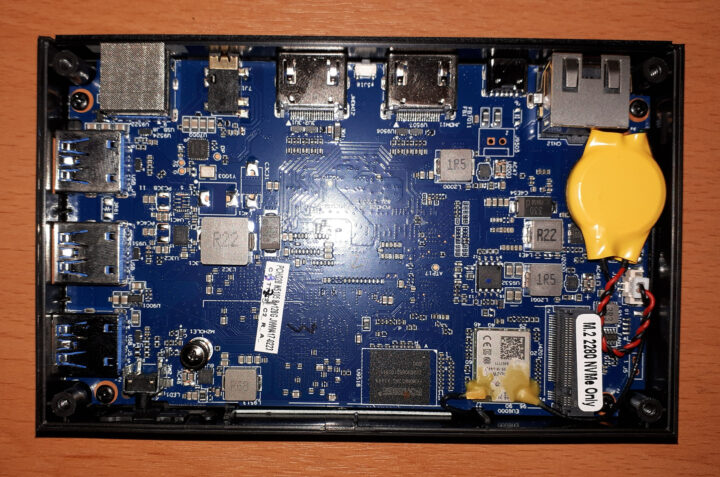
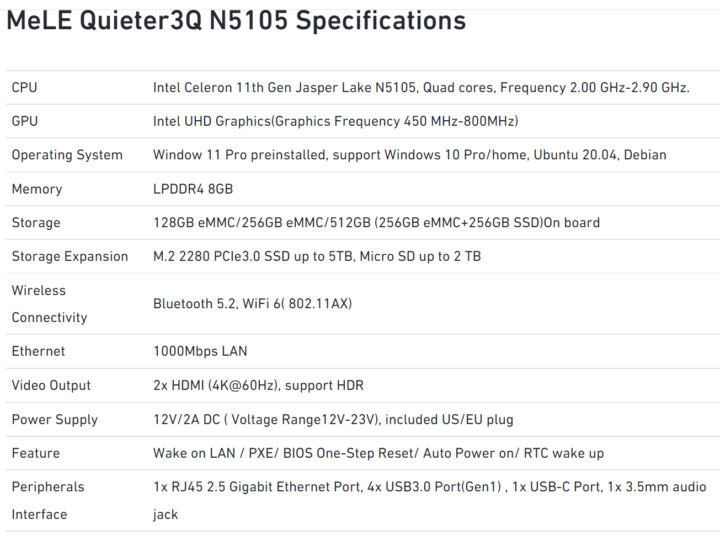
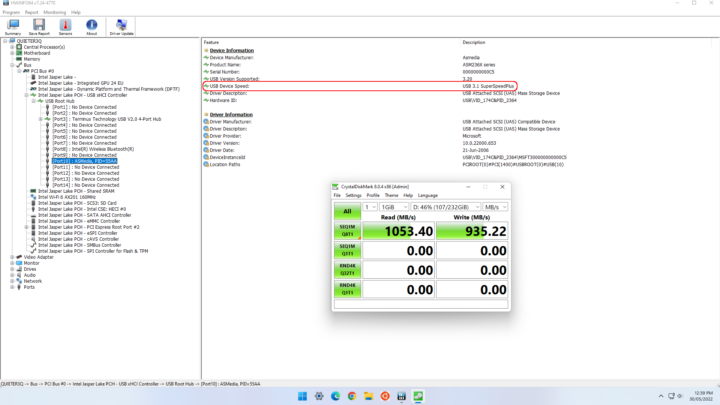
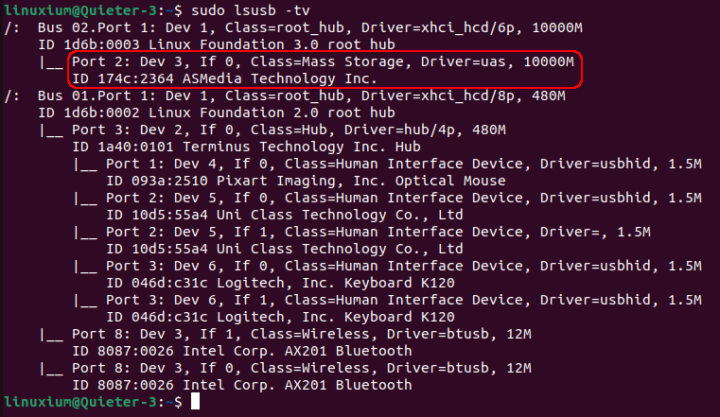
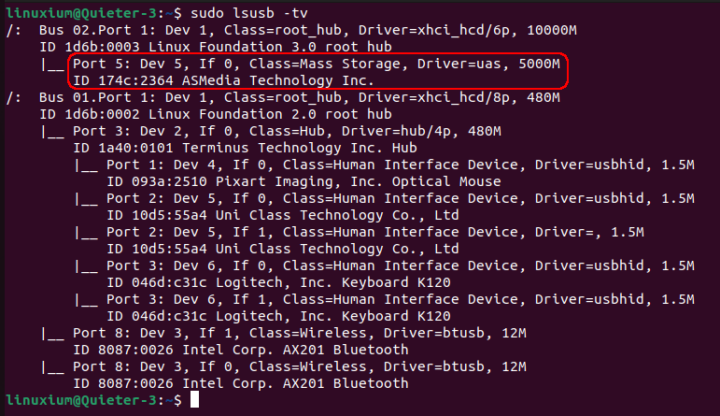
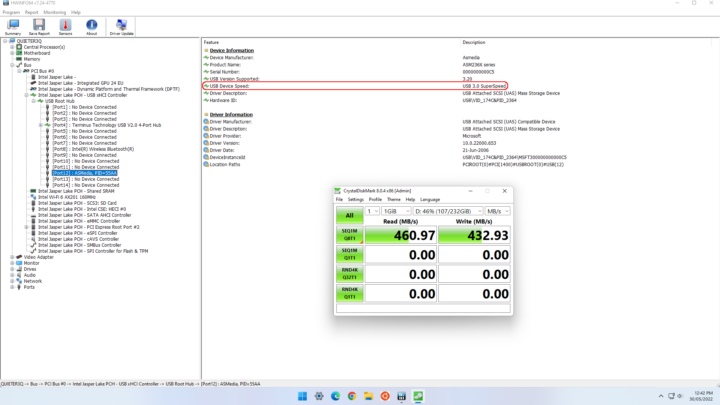
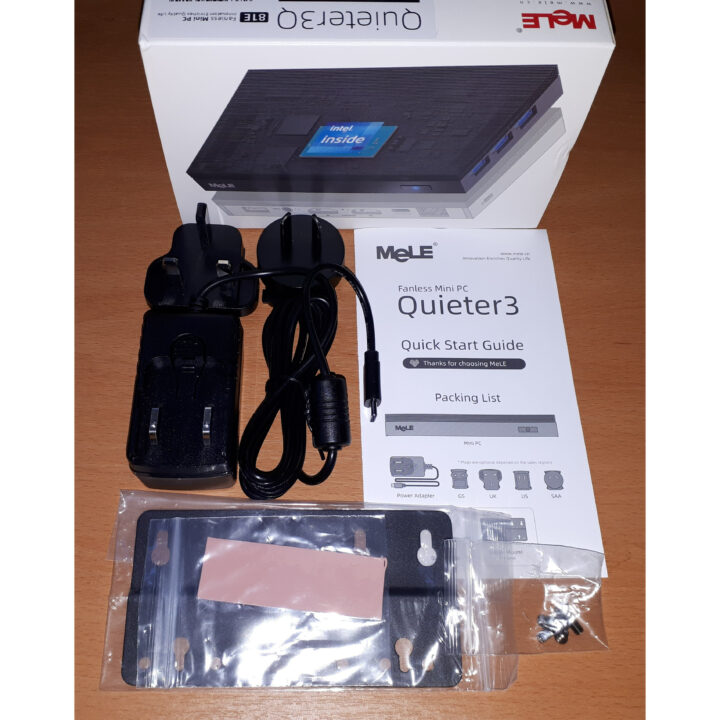
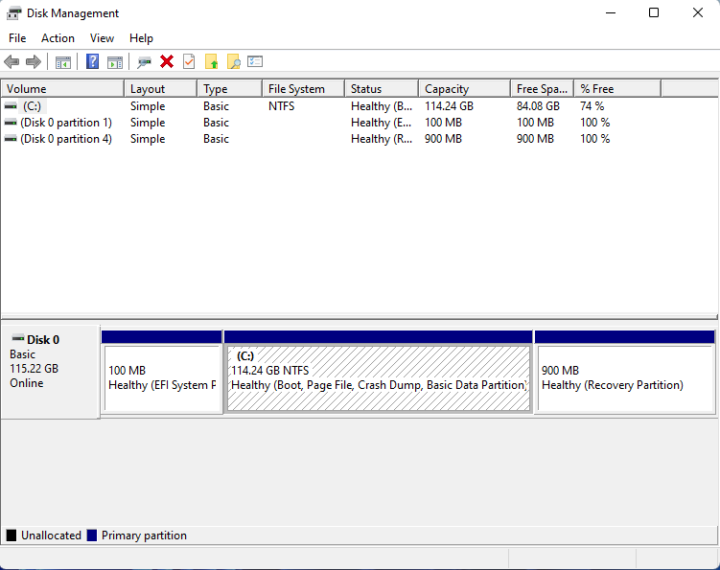
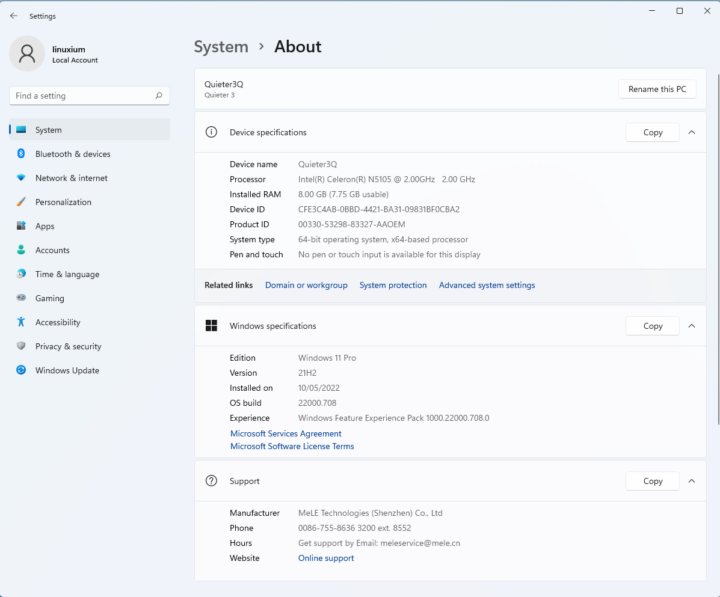
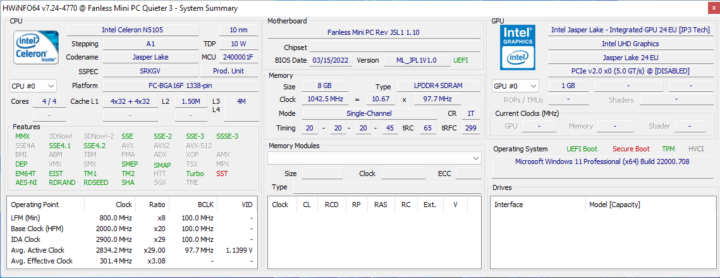
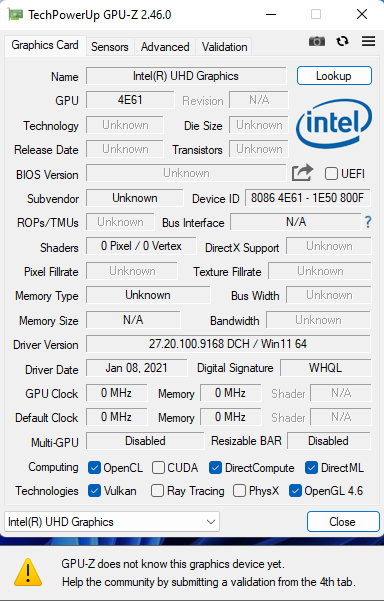
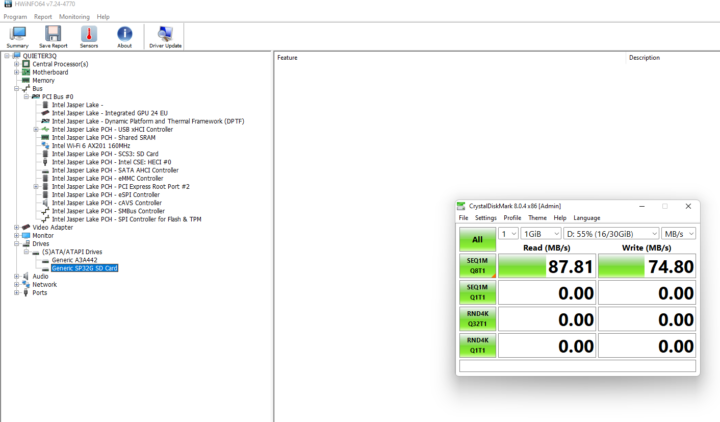
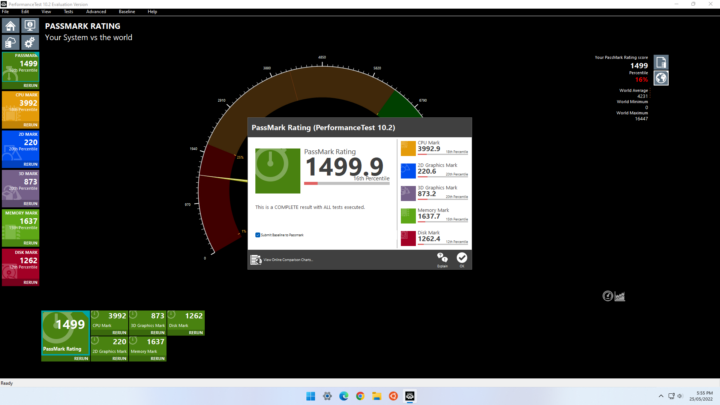
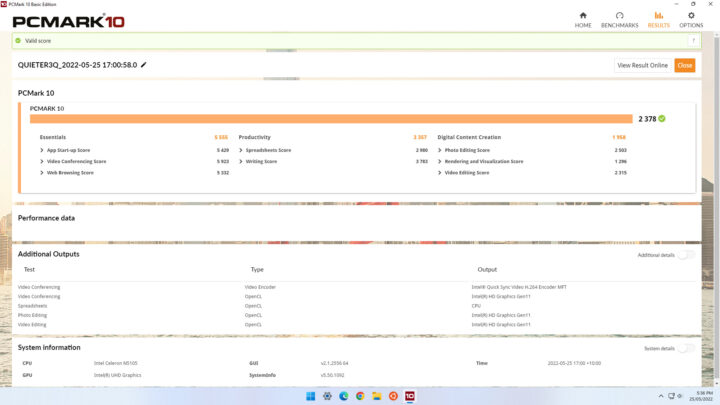
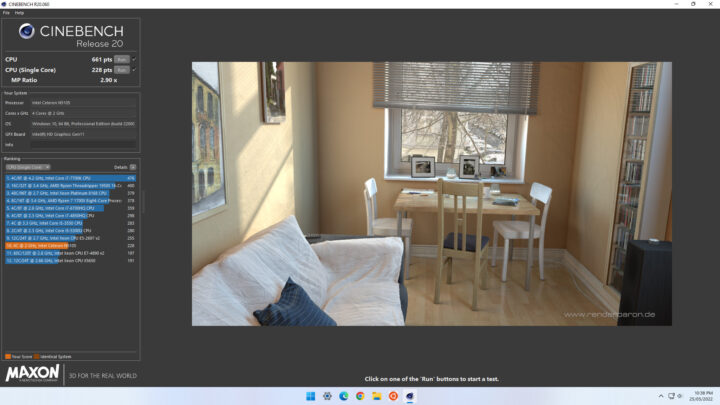
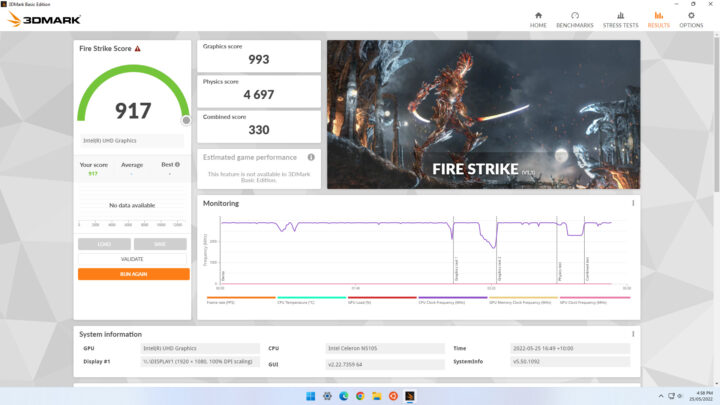
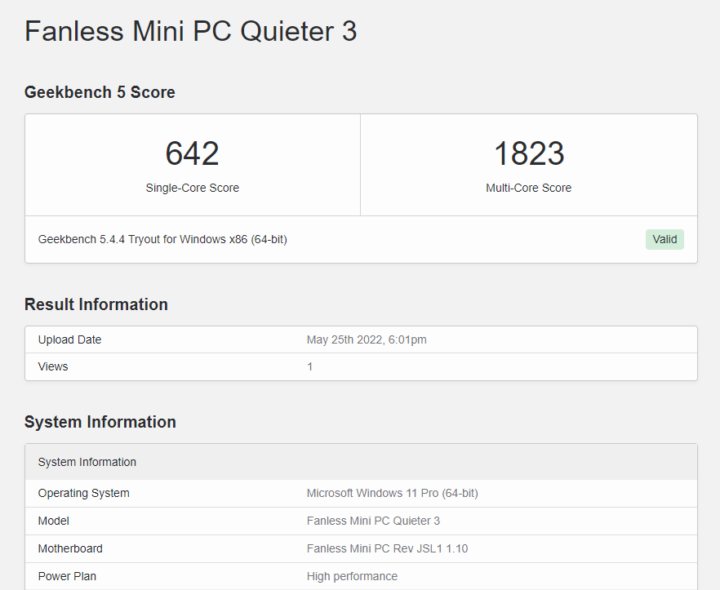
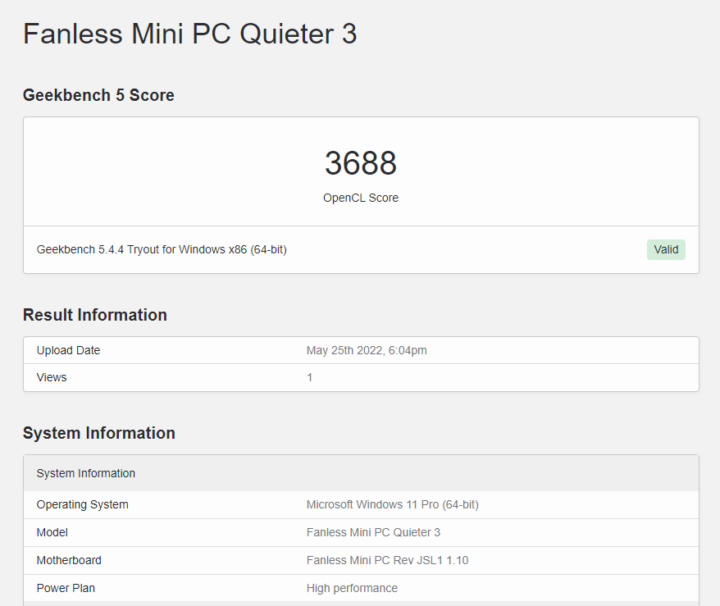
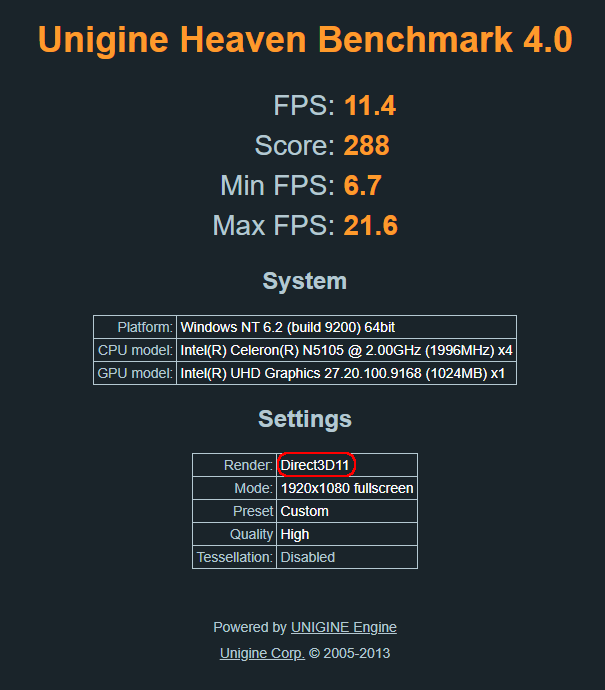
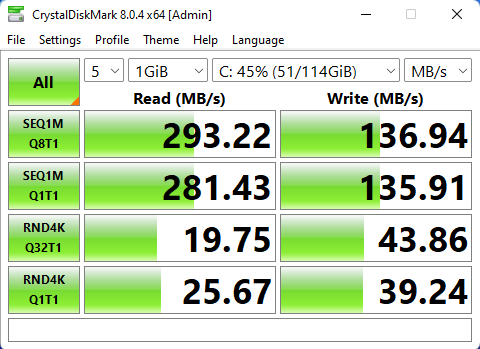
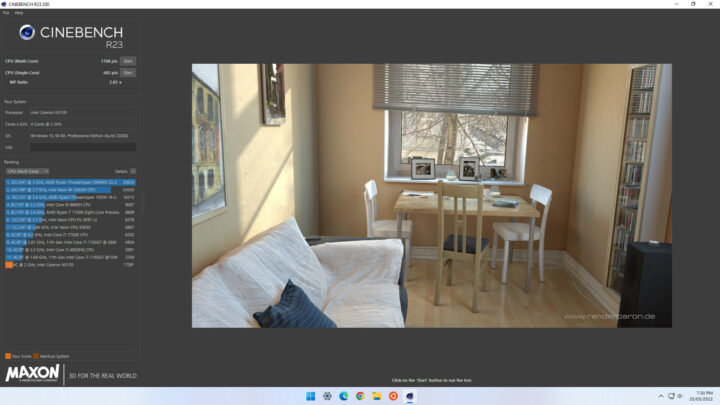
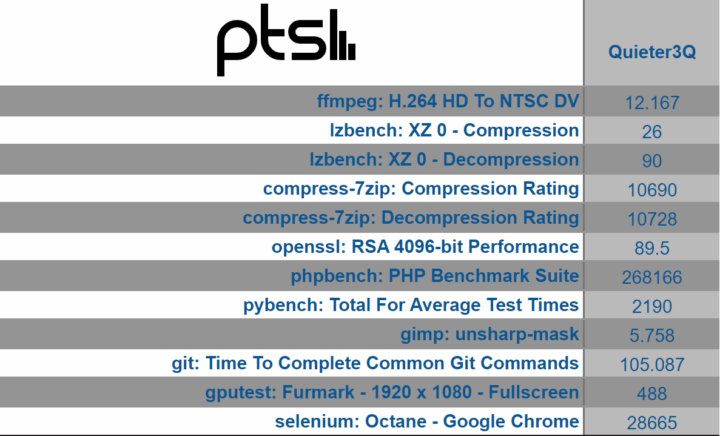

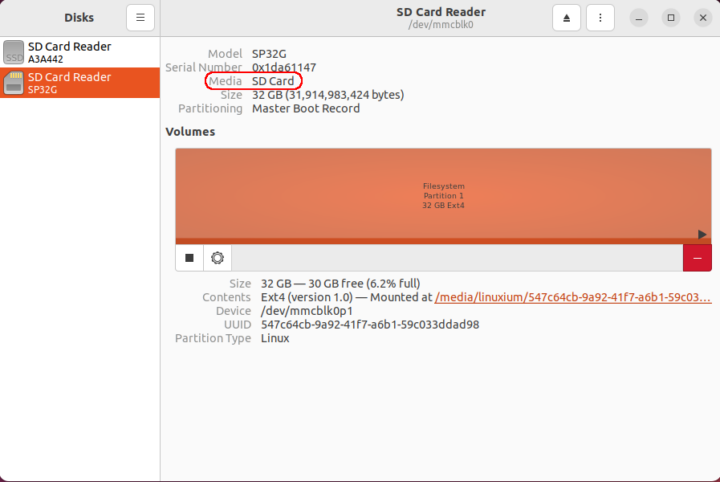
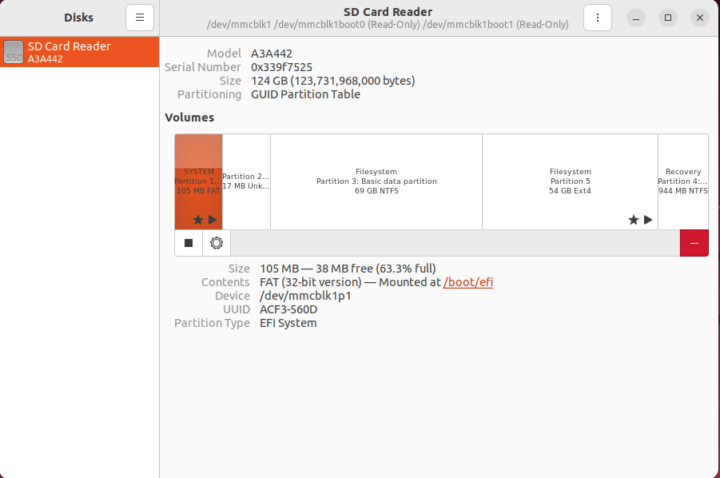
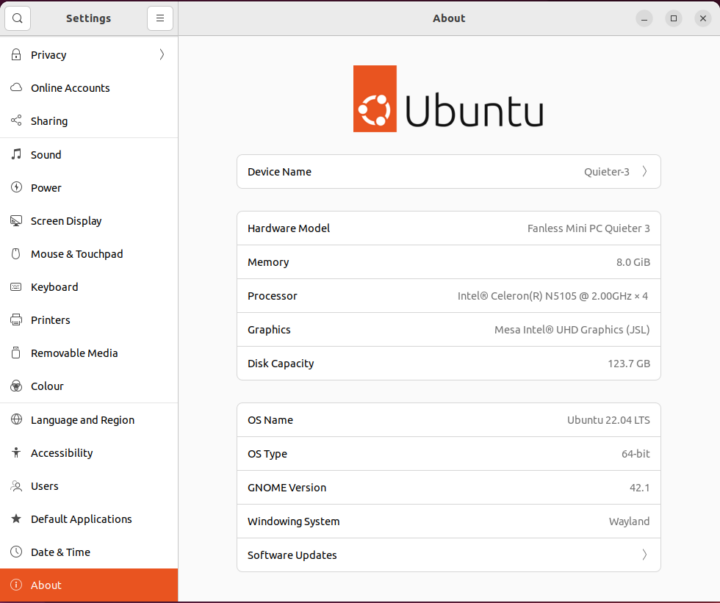
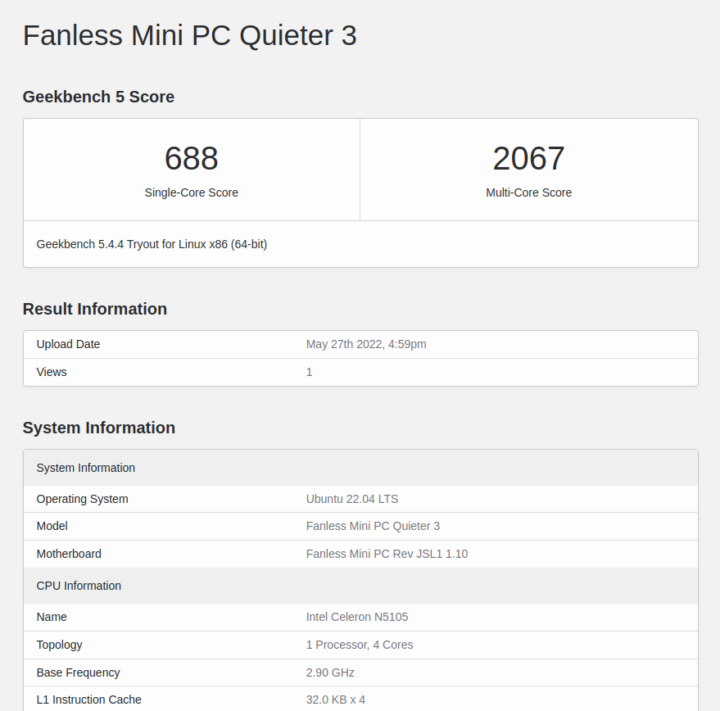
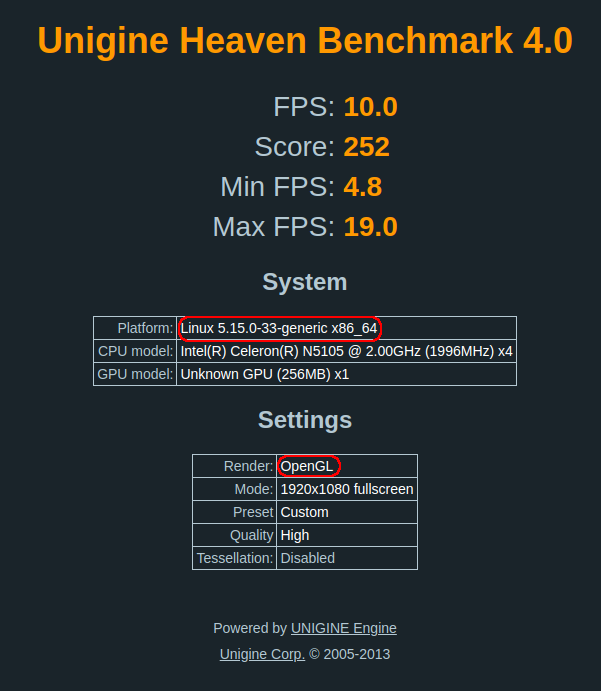
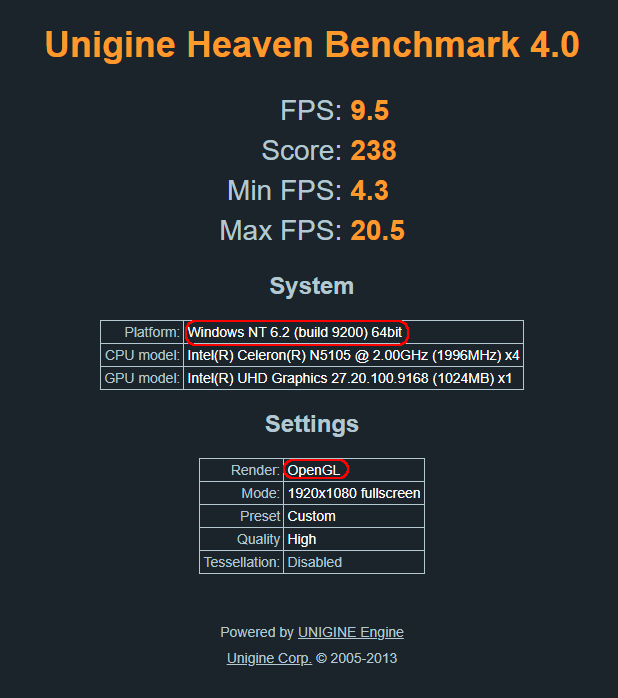
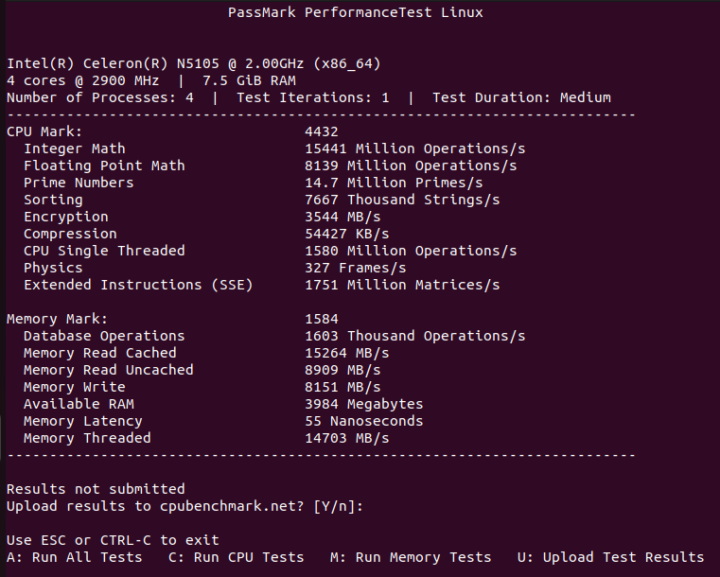
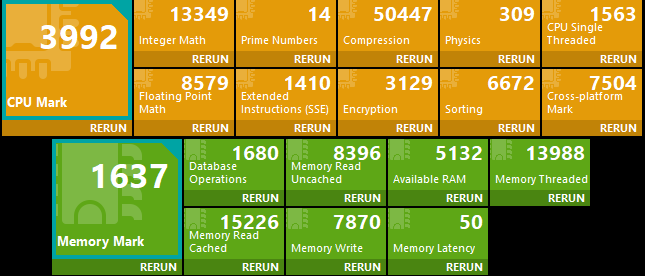
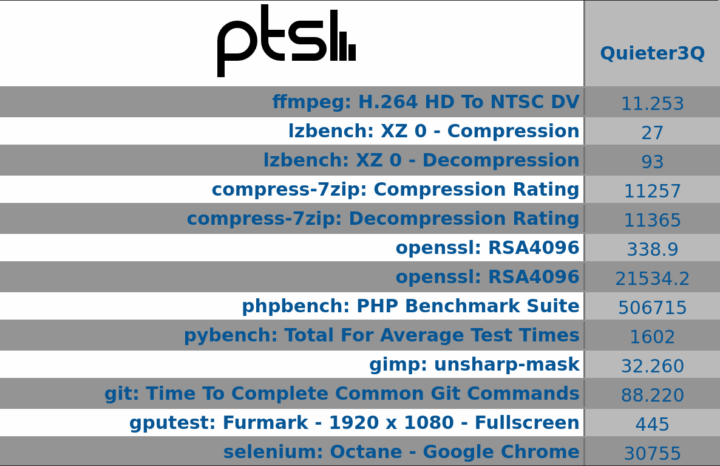

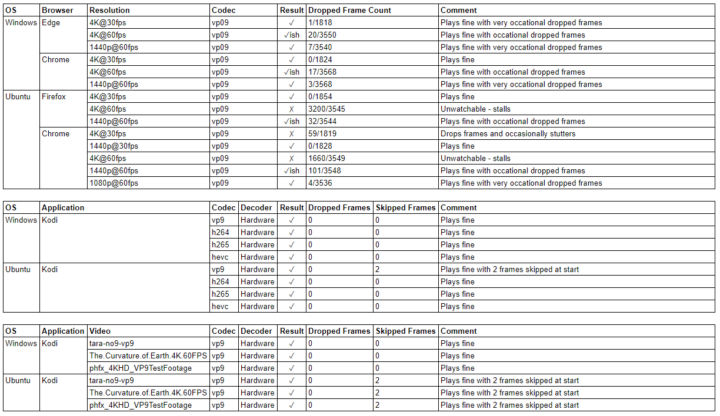
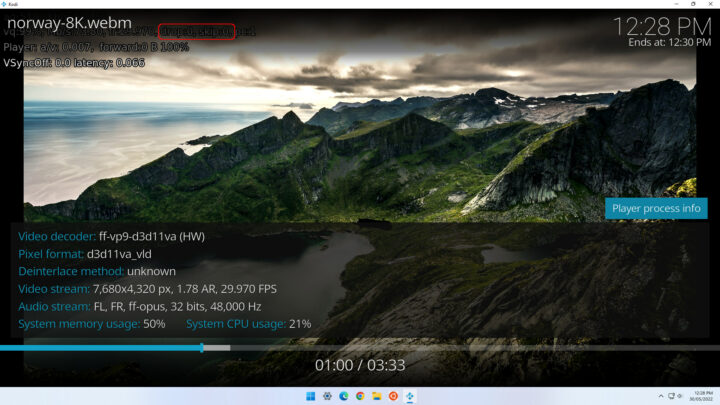
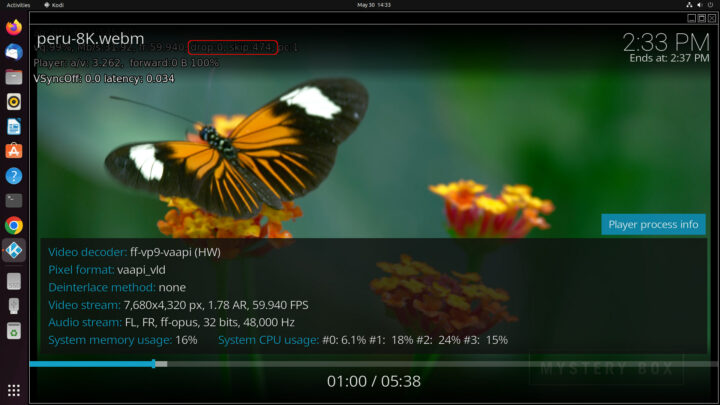
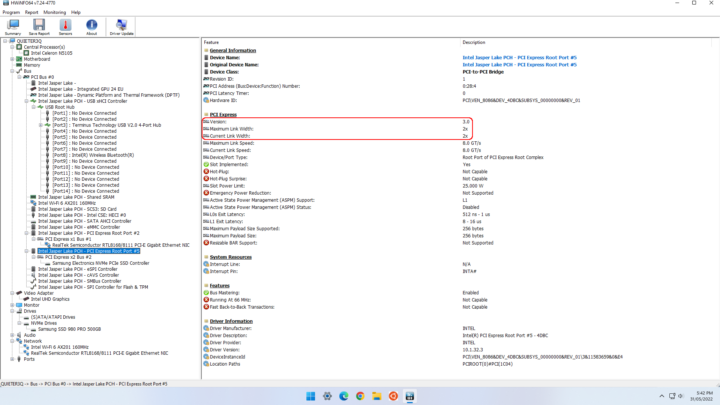
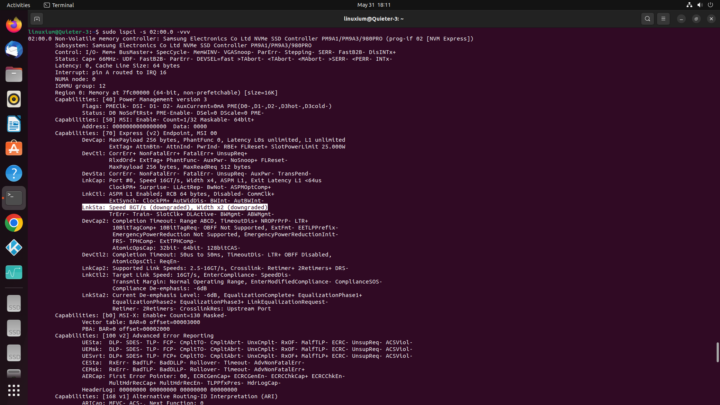
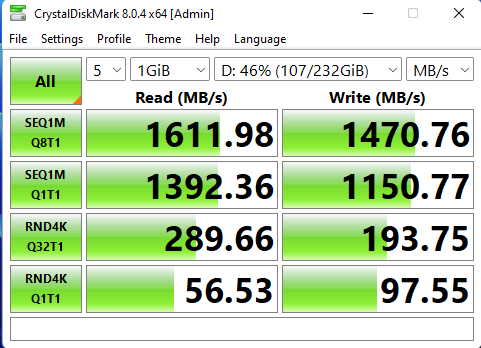
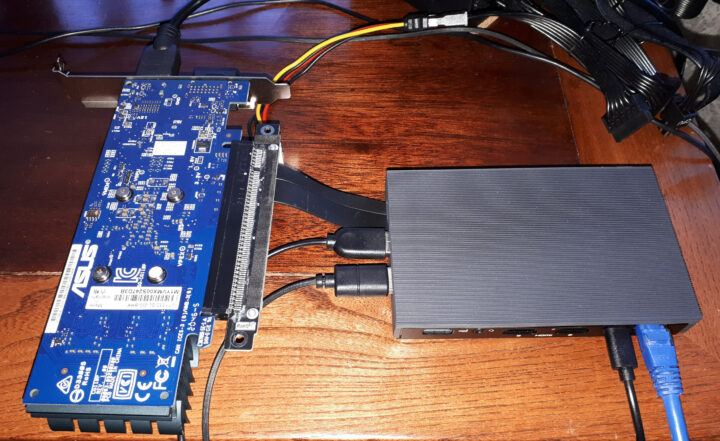
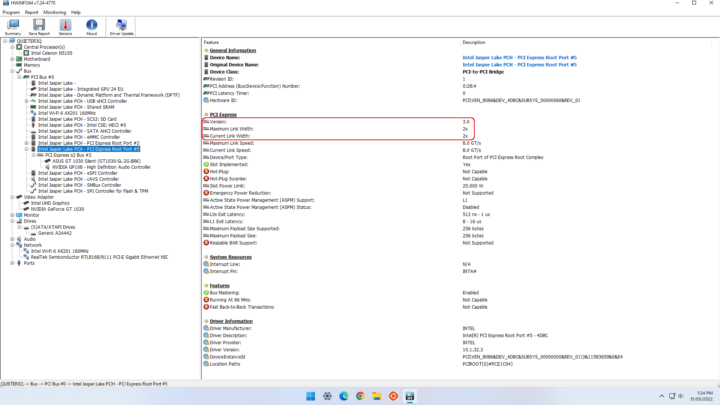
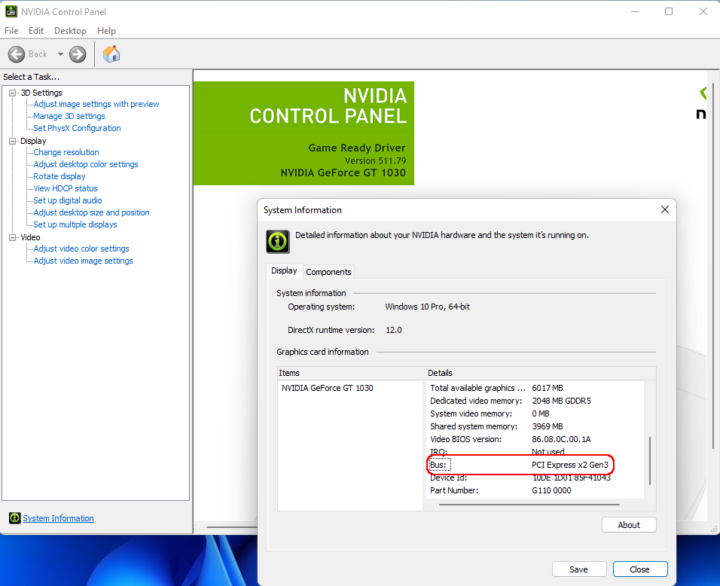
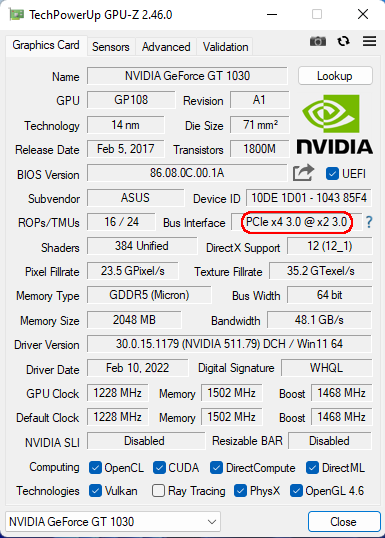
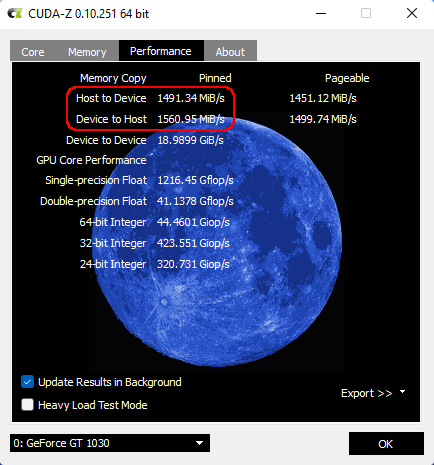
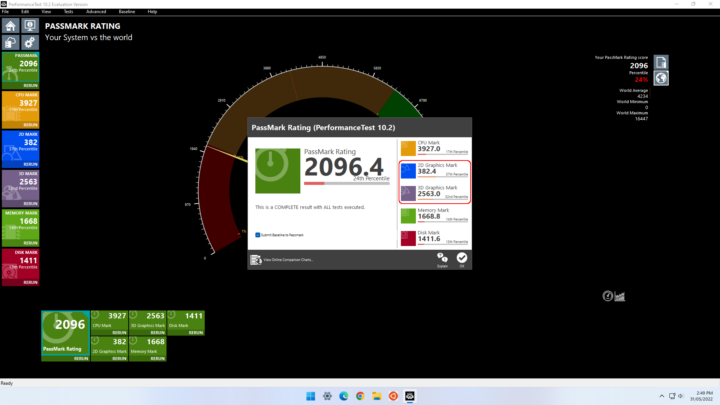
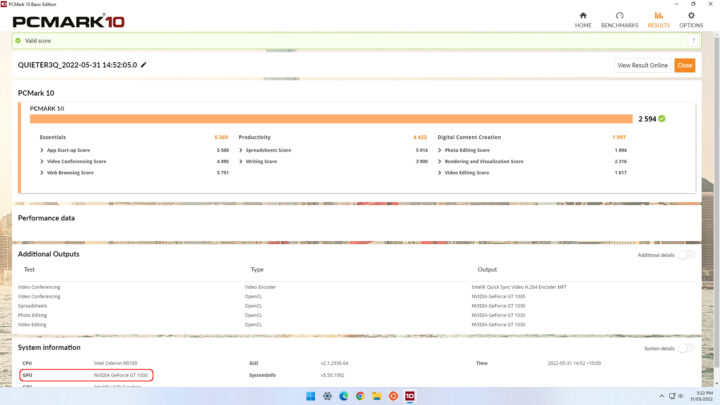
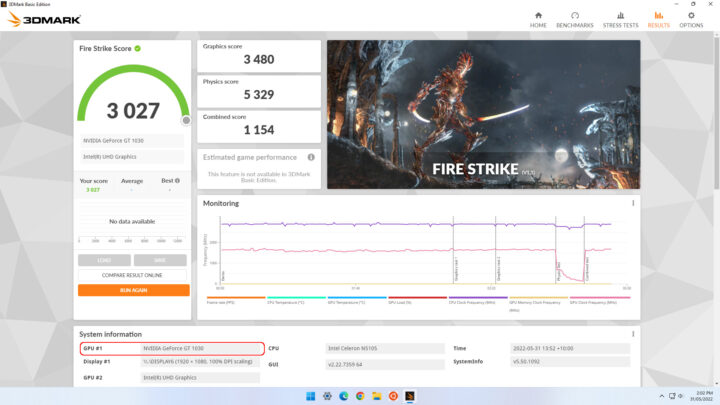
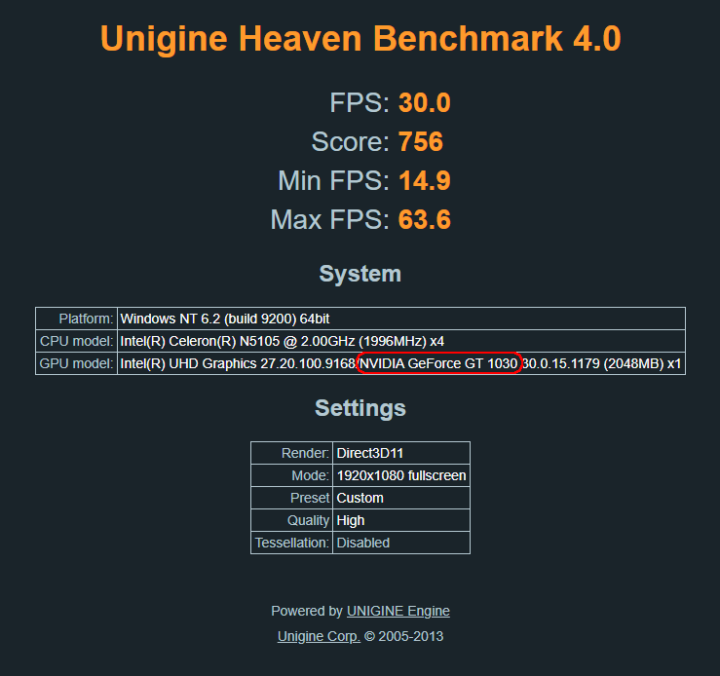
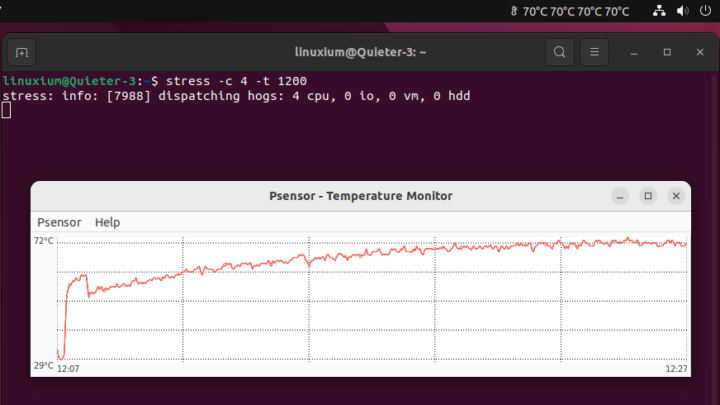
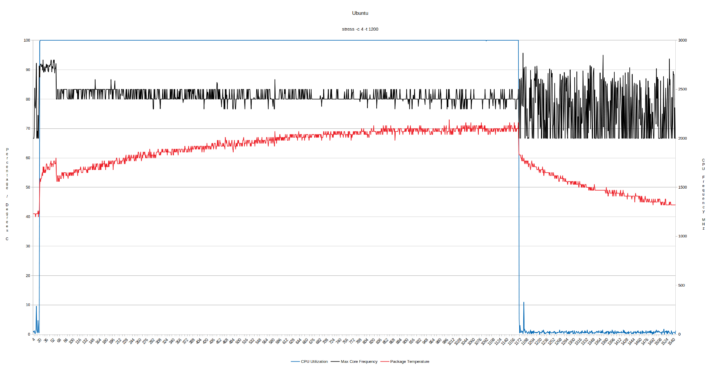




Very interesting review, I think that matches exactly what we’ve been looking for for our meeting room, finally!
Thank you for the review. Those complete device power and performance numbers are very interesting. Could you publish the source for linux-mini-pc-comparison-june-2022-720×208.webp as .ods or .csv for us readers to download? Then we could easier compare some devices of interest using LibreOffice Calc with e.g. freezing the first row and column and filtering etc.
The mini PC comparison charts are published only as images in order to offer me at least some form of ensuring copyright protection.
The number for the Gimp benchmark for this device in linux-mini-pc-comparison-june-2022-720×208.webp seems incorrect. It is very different from the others.
This is because I am now using GIMP version 1.1.3 as a result of having to upgrade to ‘Phoronix Test Suite’ version 10.8.3 (see ‘Review Methodology’) because after moving to Ubuntu 22.04 LTS some benchmarks needed updating to run. For example PTS Linux OpenSSL version 1.9.2 failed and required version 3.0.1 as did, incidentally, compiling the Linux kernel v5.4 which is why I now use v5.15. I too noticed the GIMP result variation so I repeated the tests and tested version 1.1.2 and then again on a reference device which showed identical behaviour in that the results for the newer… Read more »
This seems like it could make a good Plex server that would be able to play 4k files and provide decent transcoding performance.
For such price you can get fanless PC with 4 x 2.5 gbe Intel nics. And it’s overpriced too 🙂
Mele Allwinner A10 memories (10 years ago already):
Mele A1000: AllWinner A10 (Cortex A8) Based Hackable Android STB – CNX Software (cnx-software.com)
Arguably the origin for the popularity of the mini PC as oposed to SBCs or the Shivaplug as the Rikomagic MK802 came a few months later which spawned mini PC ‘sticks’ and Intel’s NUC the following year.
That was the post that propelled CNX Software to a greater audience:
https://www.cnx-software.com/2012/05/17/74-usd-allwinner-a10-android-4-0-mini-pc-usbhdmi-stick/
Hello! Great review! I stumbled on one feedback about this mini PC indicating the user was not able to boot OS from the NVMe disk. They were trying to clone the factory OS from the eMMC using Macrium. Cloning went fine but they were not able to boot. Can you please confirm this?
I haven’t tried booting from an NVMe drive on the Quieter 3Q but it worked without issue on the Quieter 2Q. However I didn’t use (and don’t recommend) image cloning as Windows can be finikerty and require the bootloader to be reinstalled after cloning. Performing a clean install together with applying the drivers from the MeLE website is the approach I’d use.
Agreed. The users was most probably experiencing bootloader issues after cloning. I personally would also opt for fresh reinstall, if I end up getting this PC and upgrading its storage. Thanks!
Which SFX power supply would you recommend for connecting the GT1030? And also, would you recommend other models of graphics card?
It doesn’t need to be an SFX power supply as an ATX power supply that includes a SATA connector can be used to power the ADT-Link adapter into which the GT1030 is connected. There is no real point in using a powerful GPU as it will be CPU bound by the Celeron processor. However the new GTX 1630 might be worth considering although it may not be good value for money given the rumoured cost of the card.
Ok, thanks for answering
Still NO dual channel Ram!
Can’t wait any longer now mele why is this happening?
Danke für den Test aber wie warm wird die M.2 bei voller Last der CPU?
Waht ist the temp of the M.2 by the hotest CPU temp?
Gruß
Tim
I didn’t specifically measure M.2 temperatures however if the included thermal pad is applied to the M.2 then the metal base plate of the case will act as a heat spreader to keep the temperature down.
Hi,
I have one of these. I think it is an early one, with different BIOS settings. If anyone has the BIOS settings and can send them to me, I would be very happy.
Can you send me your bios settings. I have an early model and I would like to make the thermal properties a little better. I would like to compare bios settings just to make sure. Thanks in advance.
Gert
It might be a week or so before I can free up a port to connect the device however what settings in particular are you looking for as it is an unrestricted UEFI (BIOS) so literally has hundreds of settings?
Can you tell me more about the power adapter? I see you listed it as 12V/2A, but it looks like a USB-C connector to me, which I’m used to it being 5V….. I ask because I am looking for a mini-pc I can power directly off a 12V battery in my car, and this gives me hope….
Several mini PCs are shipping with a 12V (fixed voltage) USB-C power adapter. If I remember correctly I’ve even seen some ship with a USB-C to 5.5/2.1mm DC jack adapter so that typical 12V power supplies can be used. So it might work if you plug the mini PC into the cigarette lighter socket of your car although it’s not something I’ve personally tried.